Ryukyu Cuisine Recipes


Recipes
Before Cooking
Names of dishes: The names of dishes are written in Shimakutuba (Okinawan language), but the dishes may be called different names depending on the area/region.
Amount and measurements: Measurements indicated are for approximately four servings. However, some recipes are indicated in units that are easier to cook.
Measurement notation: 1 teaspoon = 5 cc, 1 tablespoon = 15 cc, 1 cup = 200 cc. Do not pack dry ingredients when measuring. Accurately measure wet ingredients by leveling them with the measuring line.
- How to make Dashi broth
How to make Dashi broth
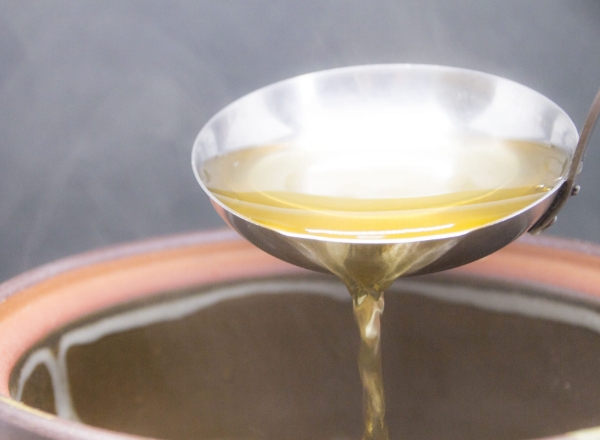
- 【Pork Dashi】
- ■ Ingredients
- Pork dashi bone (or meat)
- Makes 1C of dashi per 100g of meat
- [Yields about 10C]
- Pork dashi bone (or meat) 1 kg
- Water 10C
- Water to add when evaporated from simmering-- as necessary
■ Instruction
- Carefully remove the fats and the marrow off the bone and cleanse underwater. Rinse the meat quickly.
- Boil some water in the pot, dip the bone from 1) and drain.
- Put the bone and the indicated amount of water in a stockpot or a deep pot and check the water level. Add the water to replenish the lost amount as it simmers. Turn on the heat and skim off the foam once it comes to a boil. Turn the heat down low, and simmer for 2 hours.
- If too much water evaporates, add water accordingly and check the water level.
- Take out the bone and strain the soup.
* Do not cover while simmering.
* If you leave the bone marrow, it gives a thick and heavy dashi stock.
* Adjust the simmering time if you make dashi out of meat, depending on how you want to use the meat.
- 【Bonito soup stock】
- ■ Ingredients
- Dried Bonito flakes 6g --makes 1C of dashi
- [Yields 4C]
- Thick bonito shavings 24g
- Water 4C
- Water absorbed by bonito shavings
■ Instruction
- In a pot, bring water to a boil, add the bonito shavings, turn the heat down low, lightly simmer for 2-3 minutes, turn off the heat, and leave it for a while.
- Strain 1) with a cloth.
- Jushi
- Rice cooked with pork and vegetables in pork broth
Jushi
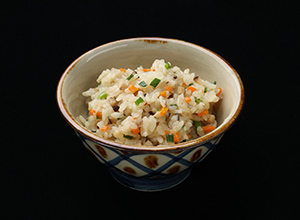
- ■ Ingredients
- rice 2C
- pork broth 2 1/4~2 1/2C
- (or pork broth + dried bonito broth)
- salt Teaspoon1~1 1/2
- soy sauce Tablespoon1~1 1/2
- pork rib 150g
- carrots 30g
- 2 dried shiitake mushrooms
- boiled fish paste 30g
- lard or salad oil Teaspoon1~2
- green onion 3~5本
■ Instruction
- Wash rice 30 minutes before cooking, put it in a basket and let the water drain off.
- Boil the whole pork rib and chop it into 5 mm squares
- Chop carrots, rehydrated dried shiitake mushrooms and boiled fish paste.
- Put pork broth, salt and soy sauce in a pot just before cooking, then add rice in (1), pork rib in (2) and chopped vegetables in (3), and cook.
- When it’s cooked, add lard, and mix the ingredients, then add finely chopped green onion, and steam the cooked rice.
■Using hot pork broth might leave a hard core at the center of the rice grains.
■If rice is cooked with lard or oil, it will hardly suck water because of the coating made by lard or oil.
■When you cook a small amount of rice, cook it over a high flame without covering the pot with a lid, and cover the pot with the lid to avoid burning when you see some holes on the rice.
■The cooked rice should be accompanied with a vinegared dish.
- Innards soup
- Clear soup with innards (pig large intestine, small intestine and stomach)
Innards soup
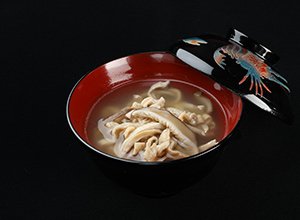
- ■ Ingredients
- innards (pig large intestine small intestine and stomach) 250g
- a suitable tofu refuse
- a suitable amount of ginger
a suitable amount of orange-peel - 2 dried shiitake mushrooms
- pork broth 2 1/2C
- dried bonito broth 2 1/2C
- salt Teaspoon1 1/4
- a small amount of soy sauce
- a minuscule amount of long pepper
- (or grated ginger)
■ Instruction
- Take out the fat of innards carefully, clean them well with tofu refuse, and wash them with hot water carefully. If you put tofu refuse on innards and leave them overnight, the smell will be gone.*1
- Put all the innards in a pot, add a lot of water and put the pot over a fire. When it comes to a boil, spill the hot water and wash them, then add water again and when it comes to a boil, spill the hot water. Repeat this 6-7 times. When the smell is gone, add ginger and orange-peel and boil them until tender for about 2 hours.
- Boiling time for stomach, that for large intestine and that for small intestine are different. So take out the softened ones. *2
- Cut the innards in (2) into 5cm long x 7mm wide.
- Rehydrate dried shiitake mushrooms with water and shred it.
- Put a suitable amount of broth in a pot and boil it. Then add innards and rehydrated dried shiitake, season them with salt, add a little soy sauce like clear soup, and cook over a medium flame for a while.
- Put the innards and soup in a bowl, and sprinkle long pepper.
※1 There are several ways to remove the smell. Another way is to fry innards with flour, vinegar and light galangal with low-temperature oil.
※2 Generally, the cooked innards are sold.
- Inamuduchi
- White miso thickened soup with lots of ingredients
Inamuduchi
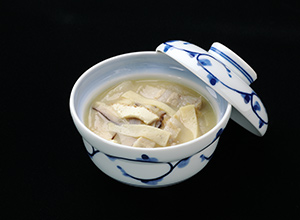
- ■ Ingredients
- pork rib 160g
- 2 dried shiitake mushrooms
- Konnyaku 160g
- thick deep-fried tofu 100g(or 2 thin deep-fried tofu)
- sponge cake boiled fish paste 80g
- pork broth 2C
- dried bonito broth 2C
- white miso(sweet)*1 80~106g
■ Instruction
- Boil the whole pork rib and cut it into rectangular slices of 4cm long x 1cm wide. Then put salt on the slices and leave them for a while.
- Put the sliced pork rib in boiled water quickly and wash it. (Take out the salt and greasiness.
- Cut all the ingredients into rectangular slices, and boil Konnyaku quickly.
- Put a suitable amount of pork broth and dried bonito broth in a pot and boil it. Add pork rib and rehydrated dried shiitake mushrooms, and boil them. Then add Konnyaku and a thick deep-fried tofu, and put white miso.
- Boil it over a medium flame for 10-15 minutes. When the ingredients absorb the seasoning and are softened, add sponge cake boiled fish paste for finishing up.
※1 Miso usage is subject to change depending on the amount of salt in white miso (6-8%)
See the following calculation formula.
[Salt content: 0.8% of the soup]
800cc × 0.8% = 6.4g
[Calculate from the amount of salt in miso]
If you use miso with salt content of 6%, the salt content in 100g of miso is 6g.
So the needed amount of miso with the salt content of 6% is 106g.
■Adjust the thickness depending on the climate. (If it’s cold, make the soup thick.)
- Squid ink soup
- Black rich-flavored soup with squid ink
Squid ink soup
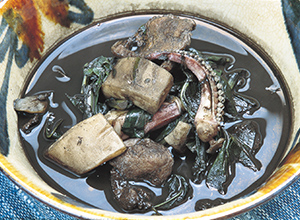
- ■ Ingredients
- White squid (bigfin reef squid) 500g
- pork 150g
- lxeris 150g
- squid ink Tablespoon1~2
- water 8C
- salt Teaspoon1
■ Instruction
- Take out the ink sac from a white squid. Open the body of the squid, peel the skin and wash it. Cut the body and legs into 5cm long x 1.5cm wide.
- Cut raw pork into thin slices.
- Cut Ixeris into the suitable length.
- Spread Ixeris in a pot, and put white squid and pork on the Ixeris. Then add a suitable amount of water and put it over a fire. When it boils and the scum rises to the surface, skim off that carefully, and boil it over a low flame until tender for about 1 hour.
- If the broth becomes less than 5 cups, add dried bonito broth, season it with salt, and mix squid ink into the soup at the end.
- Rafute
- Boiled cubes of pork rib. Seasoned with sugar, soy sauce and Awamori
Rafute
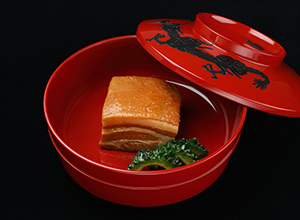
- ■ Ingredients
- pork rib 700g dried bonito broth 4と 1/2C(or pork broth)
- Awamori (20-30% of the weight of pork)
- sugar
- soy sauce (koikuchi)
- soy sauce (usukuchi)
■ Instruction
- Broil pork rib on an open fire lightly, and soak it in hot water quickly.
- Put hot water in a thick pan. When it boils, put the block of pork rib in (1), skim off the scum and boil it over a low flame until tender for about 1 and half hours., then cool it off (While cooling it off, press the pork for shaping).
- Cut the pork rib into 4-5 cm squares. Weigh the pork rib and calculate the necessary amount of seasoning in accordance with the weight.
- Put a suitable amount of broth and Awamori in a pot, and put the pot over a fire. Boil it over a low flame for an hour (Remove the scum and fat).
- Next, add sugar and boil it for an hour, then add half of the soy sauce, and boil it for 2 hours. At the end, add the rest half of the soy sauce and boil it for another 2 hours.
- When the pork rib becomes tender enough to be cut with chopsticks, turn off the fire.
- ※Boil it without a lid.
■Weigh the weight of the pork rib before boiling and adjust the amount of seasoning as follows.
Seasoning ratio (based on the weight of pork)
sugar 4~4.5%
salt content (soy sauce) 1.5~2.0%
[Guide to use]
white soft sugar Tablespoon1=9g Teaspoon1=3g
soy sauce (salt) Tablespoon1=3g Teaspoon1=1g
- Tanmu (taimo) Dingaku
- A celebratory dis h of sweet and sticky taro
Tanmu (taimo) Dingaku
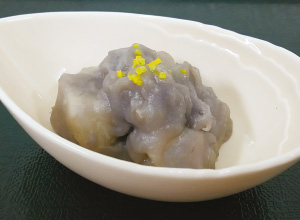
- ■ Ingredients
- Tanmu (taimo potato) 300g
- Hot water 1C
- Sugar 40g
- Mirin (sweet sake) 1/2 Tablespoon
- Salt a little
■ Instruction
- Dice the Tanmu in 2cm cubes, boil in hot water for 5 minutes, remove the foam, and drain.
- Add 1C hot water, Tanmu and the sugar in a pot, turn on the heat. Once Tanmu softens, add mirin and salt, lower the heat and mix with a rice paddle.
- As the edges round off while mixing, the juice thickens. Finish when half of the Tanmu is mashed.
■Taimo potatoes are native to Okinawa, characterized by their smell and stickiness.
■Taimo potatoes signify the prosperity of descendants, and it is essential for any celebratory feast.
■Some may finish the dish with a sprinkle of ginger or orange peels on top.
- Jimami-dofu (Okinawa peanut tofu)
- Dish of Jimami (peanuts) kneaded with sweet potato starch like tofu
Jimami-dofu (Okinawa peanut tofu)
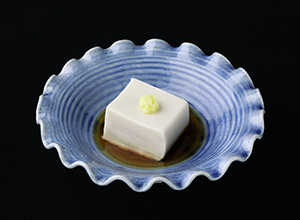
- ■ Ingredients
- raw peanuts 2C
- sweet potato starch 1C
- water 6C
- [dipping sauce]
- dried bonito broth Tablespoon5
- usukuchi soy sauce Tablespoon1 ~1 1/2
- sweet cooking sake Tablespoon1
- a small amount of grated ginger
■ Instruction
- Soak raw peanuts in hot water. When the hot water becomes less hot, peal the skin of the peanuts and wash them.
- Put the peanuts in (1) and about half of the water (3 cups) in a blender. When the peanuts become smooth (without rough deposits), put them in a bowl and squeeze them. (The squeezed juice will be used later). *1
- Dissolve sweet potato starch in the rest of water (3 cups), and strain it.
- Put the squeezed juice in (2) in a thick pot, and boil it over a medium heat. When it boils and the smell of raw peanuts has gone, add the dissolved sweet potato starch and mix them, kneading them constantly with a ladle. When it hardens, turn down the flame to medium one. Then the hardened stuff will be softened again.
- When you keep kneading it for about 30 minutes, the milky white liquid will become sticky and glossy. And when it becomes paste until it can be scooped up with a wooden pestle, turn off the fire.
- Spread a wet dish towel on a can mold, pour the paste in (5) into the can mold quickly, level out the surface, and cool it down to harden it by putting it in water.
- Put dried bonito broth, usukuchi soy sauce and sweet cooking sake in a small pot, and boil it, then cool it down for preparing dipping sauce.
- Pour a small amount of dipping sauce in a bowl, arrange the Jimami tofu cut into a suitable size, and put grated ginger on it.
*1 If you squeeze them too strongly, a dish towel might be broken. So make the towel dual and make a bag.
■You can check the degree of kneading by putting a small amount of it into iced water.
- Minudaru
- Dish of pork loin flavored with black sesame sauce and steamed
Minudaru
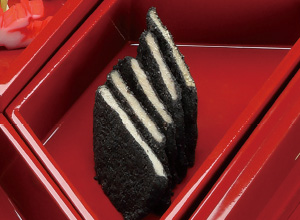
- ■ Ingredients
- 8 pieces of pork loin (thickness)
- black sesame 100g
- dipping sauce ratio
- soy sauce Tablespoon2
- sweet cooking sake Tablespoon2
- sugar Tablespoon2
- sake Tablespoon1
■ Instruction
- Cut off the fat from the pork loin or cut the muscle of the pork, and tap the pork with the back of a knife lightly. Soak it in a suitable amount of dipping sauce for 2-5 hours, and let the water drain off.
- Roast black sesame and rub it well until the oil comes out. Add the dipping sauce in (1), rub it well and mix it to make thickened sesame sauce.
- Wipe off the moisture of the pork in (1) and put the sesame paste in (2) on the pork.
- Spread a sheet of cooking paper in a heated steamer, and arrange the pork in (3). Steam it over a high flame heat for the first 2-3 minutes, then turn down the flame to medium one, and steam it for about 10-15 minutes, depending on the thickness of the pork and cool it down.
- Stir-fried and boiled kelp
- Dish of shredded kelp fried and boiled with ingredients
Stir-fried and boiled kelp
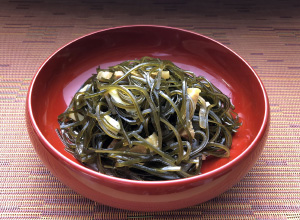
- ■ Ingredients
- long slice of kelp or shredded kelp 40g
- pork rib 75g
- soy sauce Tablespoon2 1/2~3
- sugar Tablespoon2 1/2
- Awamori Tablespoon1 1/2
- sweet cooking sake Teaspoon2
- Konnyaku 80g
- red boiled fish paste 40g
- salad oil Tablespoon2
- pork broth 2 1/2~3C
- a small amount of salt
■ Instruction
- Wash a long slice of kelp and rehydrate it with water. Let the water drain off in a basket and shred it.
*1 Leave the shredded kelp as it is and wash it, then soak it in water until the curls are removed. When it’s straightened, wash it again and let the water drain off. - Boil the block of pork rib and cut it into rectangular slices.
- Cut Konnyaku into rectangular slices, and boil it from water.
- Put soy sauce, sugar and Awamori in a small pot, and boil it. Then put the pork rib in it and infiltrate the flavor into the pork and take out the pork rib.
- Heat oil in a pot, and put kelp in it and fry the kelp well. When the kelp is coated with oil well, put pork broth and meat juice in the pot. Cover it with an in-pot lid, and boil it until the kelp is softened (If the broth is reduced, add pork broth several times, and boil it until the kelp is softened for about 40 minutes).
- Add the pork rib in (4), Konnyaku, and sweet cooking sake in the middle, further boil it and finish.
- Arrange the softly boiled kelp on a plate, and put finely chopped red boiled fish paste on it.
*1 Fold a piece of kelp like a screen, wrap it with another kelp and fix it with a toothpick, then cut it for cutting smoothly.
- Goya Chanpuru
- Fried Goya, tofu and pork dish
Goya Chanpuru
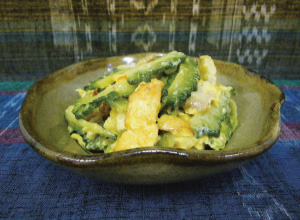
- ■ Ingredients
- Goya (bitter gourd) 400g
- Shima dofu (Okinawan-style tofu) 400g
- pork rib 120~160g
- 2 eggs
- oil used for frying Tablespoon2
- a suitable amount of salt
■ Instruction
- Boil the block of pork rib and cut it into rectangular slices
- Wash Goya and cut in half vertically. Then take out the seeds and cotton with a spoon. Slice it thinly, put salt on it, and squeeze the water lightly.
- Wipe off the water on tofu.
- Put 1 tablespoon of oil in a pan, add tofu torn off by hand, and fry it. When it’s browned, take it on a plate.
- Put the rest of oil in a pan and fry pork rib over a high flame. Add the Goya in (2) and season with salt, then add the tofu in (4).
- Pour beaten eggs into (5), and mix them well for finishing.
■Chanpuru is a dish of fried Okinawan-style tofu and seasonal vegetables. Fry it crisply without making it watery.
- Racchou (Okinawa Shallot) Champuru
- Champuru, with the fragrant aroma of Okinawan Shallot
Racchou (Okinawa Shallot) Champuru
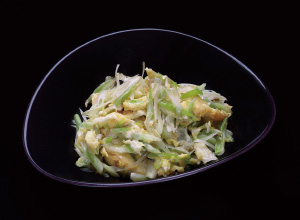
- ■ Ingredients
- Racchou (Okinawa shallot)(net weight) 200g
- Salt 1/2 Teaspoon
- Shima tofu (Okinawan-style tofu) 200g
- Cooking oil 2 Tablespoon
- Salt 1/2 Teaspoon
- Eggs 2
■ Instruction
- Remove the thin skin and the root off the racchou, slice diagonally and season lightly with salt.
- Pat off the water from the tofu and tear off pieces by hand.
- Add 1 tablespoon of oil to a frying pan, heat the pan on high, add tofu, sear until brown (called 'akayachi' in Okinawa), and transfer on a plate.
- Add oil to the pan in 3), cook racchou quickly in high heat, add tofu and add salt to taste.
- Finally, pour the beaten eggs and mix them all together to finish.
■Okinawa shallot is a seasonal ingredient found around early spring.
■The shallot is characterized by its crispy texture and refreshing aroma.
■Okinawa shallot is used for making light pickles and tempura.
- Chinbin
- A rolled up crepe, thinly flour containing brown sugar syrup
Chinbin
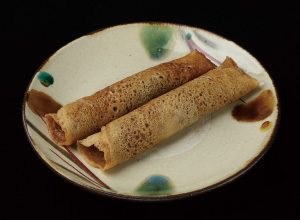
- ■ Ingredients
- Flour 200g
- Baking powder 1 Teaspoon
- [Brown sugar syrup (2C)]
- Brown sugar (powder) 1 1/2 C
- Water 1 1/2 C
■ Instruction
- Sift flour and baking powder together
- Put the water and brown sugar in a pot and put it over the fire. Bring to a boil, remove the foam, turn off the heat and let it cool. (Measure 2 cups of brown sugar syrup)
- Add the flour from 1) into a bowl and stir the cooled brown sugar into the flour to make a batter. (Pass the batter through a strainer if there are lumps)
- Lightly coat a well seasoned frying pan with oil (such as wiping the pan with oil-soaked paper). Once the pan starts smoking, pour in the batter with a ladle while rotating the pan.
- Flip the crepe once the surface has bubbles and is a little dry.
- Gently roll the crêpe away from you, with the side you first cooked in 5) facing the outside of the roll.
■OA well-cooked crêpe will have bubbles on the surface
■One of the traditional pastries since the Ryukyu Dynasty. There is a record of this crepe being presented to the Lord of Satsuma.
■This crêpe is different from Po-Po. Referring to Chinbin as red Po-Po is incorrect.
- Sweet potato starch andagi
- Fries made from sweet potatoes and sweet potato starch
Sweet potato starch andagi
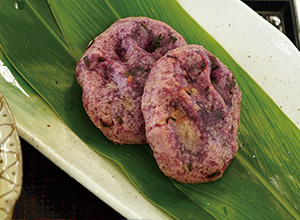
- ■ Ingredients
- sweet potatoes (net)300g
- sweet potato starch 210g
- dried bonito broth 150~160cc
- salt Teaspoon1 1/2
- Chinese chives 45g(1/2C)
- a suitable amount of oil used for frying
■ Instruction
- Wash sweet potatoes, cut them into 3-4 equal pieces and peel the skin thickly. Soak them into water to remove astringent taste, and steam them (boil them).
- Strain the cooked sweet potatoes while they are still hot, or mash them(300g).
- Wash Chinese chives and let the water drain off, then cut it into 5mm long.
- Dissolve salt in a suitable amount of dried bonito broth.
- Put sweet potato starch in a bowl, add the broth in (4) to it little by little and mix them. Add the sweet potatoes in (1), kneading them to produce a proper hardness.
- Add Chinese chives to (5) and mix them lightly.
- Take a scoop of (6) and bunch it up together. When it takes a high polish, make oval shapes and put finger signs on them.
- Heat the oil for frying to medium temperature (170 ℃) and put (7) in the oil. When they come to the surface, turn them over and fry them for several minutes for crispy finish.
■If the dough is too soft, strain the sweet potato starch with a strainer, and use it by making it in powder form.
- Sata andagi
- Okinawan sweet deep-fried bun made from eggs, sugar and flour
Sata andagi
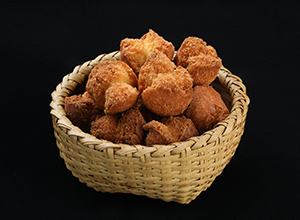
- ■ Ingredients
- 2 eggs (M size)
- granulated sugar 115g
- flour 200~220g
- baking powder Teaspoon2
- salad oil Teaspoon2
- a suitable amount of oil used for frying
■ Instruction
- Sieve flour and baking powder together.
- Put 2 eggs in a bowl and whip them. Add sugar and mix them well without beating them.
- Add flour in (1) to (2) and mix them well. Add salad oil and mix them further.
- Put a little oil on the hands and make small balls of 2 cm in diameter. Put the balls in oil at 150-160℃.
- The balls will sink to the bottom at the beginning, but they will slowly come up to the surface in 20-30 seconds. The balls will blow up, rotating, and one point will break up and open to a tulip shape.
- When they become brownish and they’re stuck through on a bamboo stick and raw dough doesn’t stick to it, they’re done.
- Duluwakashi
- Dish of taimo, stems of taimo, pork kneaded with pork broth
Duluwakashi
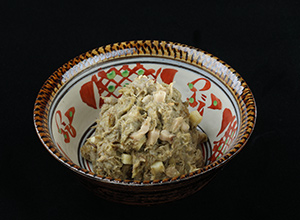
- ■ Ingredients
- taimo 300g
- stems of taimo 350g
- pork rib 40~70g
- 2 dried shiitake mushrooms
- green peas 30g
- sponge cake boiled fish paste 30g
- pork broth 1~1 1/2C
- lard or salad oil Tablespoon1/2
- a small amount of salt
■ Instruction
- ①Wash stems of taimo, and cut them into 3 cm long. Soak them into water to remove their astringency. Boil them in hot water until tender, and drain water well.
- ②Peel the skin of taimo, cut it into big pieces, and boil it. Mash it when it’s hot.
- ③Boil the block of pork rib, and cut it into 4mm squares.
- ④Rehydrate dried shiitake mushrooms with water and cut them into 4mm squares.
- ⑤Heat lard in a pot and fry pork rib until fat comes out, then fry stems of taimo and shiitake mushrooms. Add taimo and pork broth, and boil them, by kneading them with a wooden ladle.
- ⑥Knead them enough until they become paste. Add green peas and sponge cake boiled fish paste, then season them with salt.
■Stems of taimo are very astringent. If you touch them with your bare hands, you will get a rash. So please use vinyl gloves.
■If stems of taimo are too large, peel the skin like pulling strings.
■Sometimes it can be seasoned with miso.

Copyright © 2018 沖縄の伝統的な食文化 All Rights Reserved.



